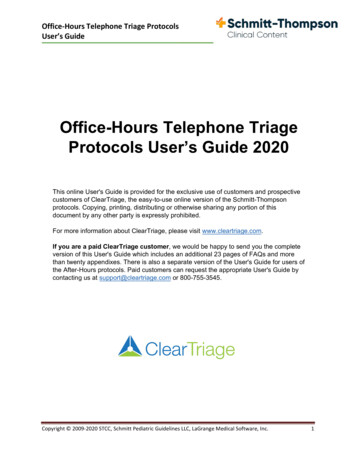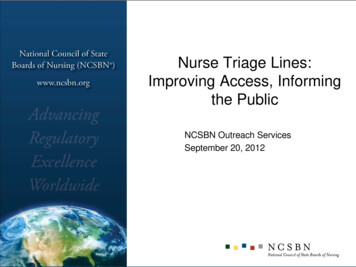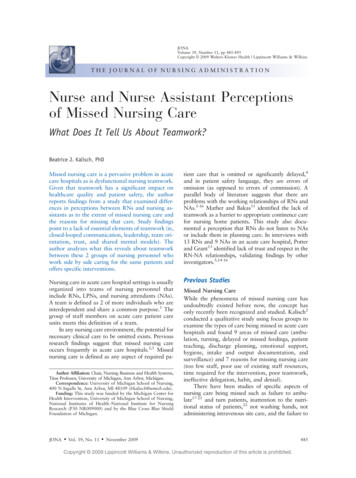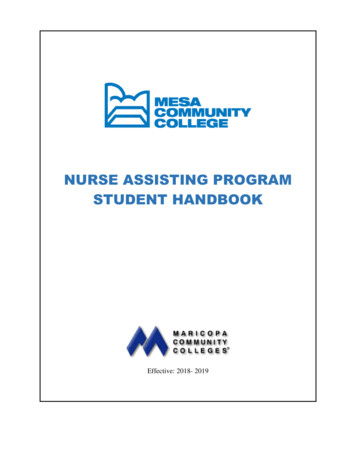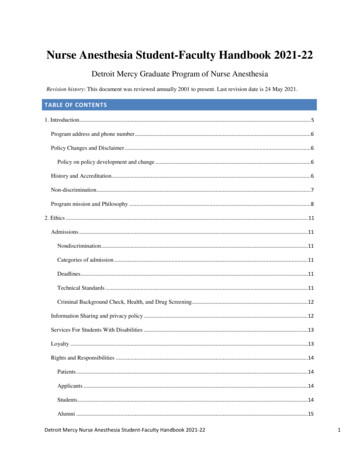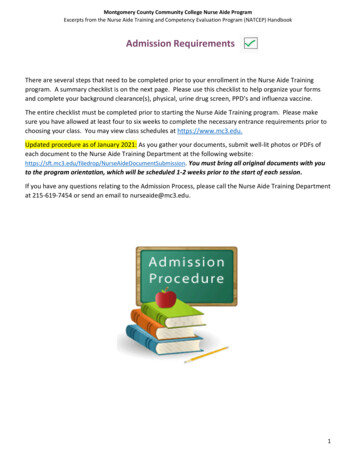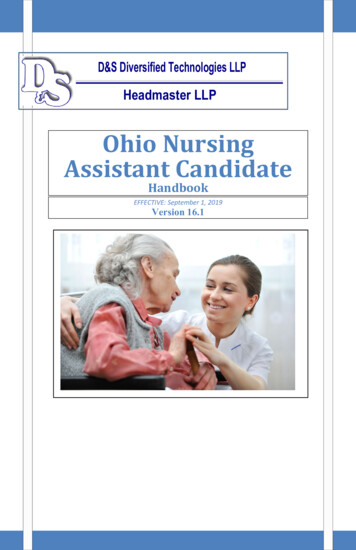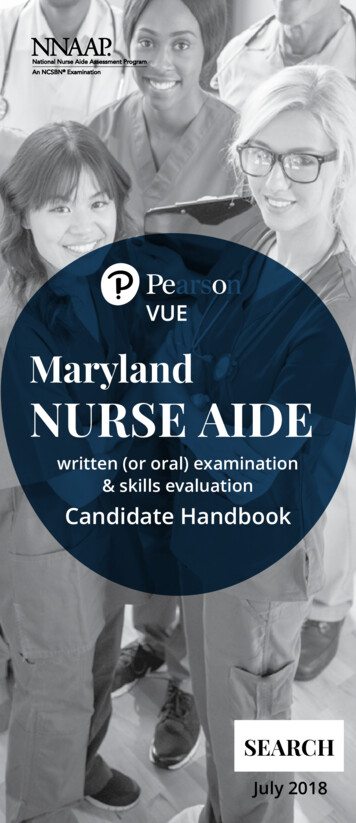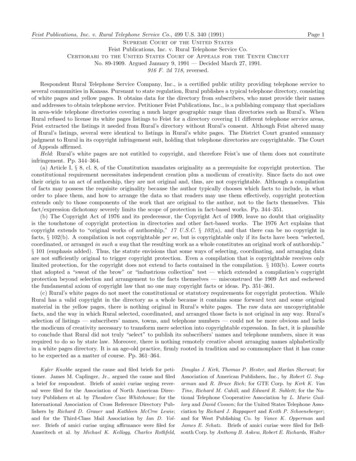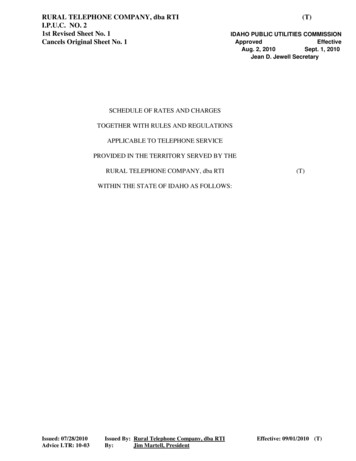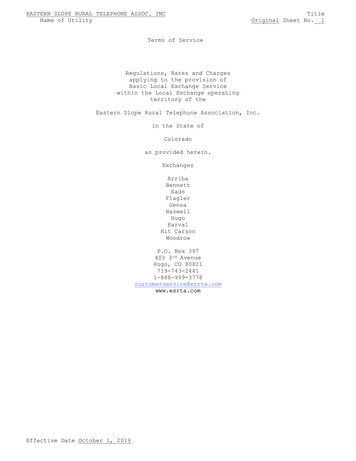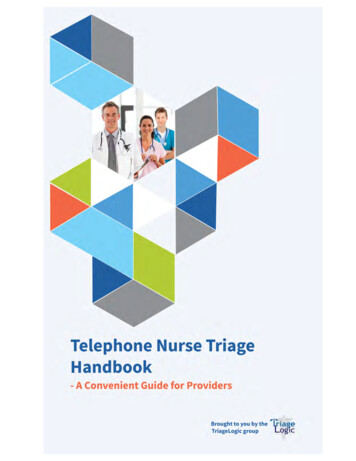
Transcription
Telephone Nurse Triage HandbookBy Charu Raheja, PhDTriageLogic GroupContributing Authors: Ravi K. Raheja, MD, Medical Director and MarciLawing, RN, BSN Nurse Education Manager
Copyright 2015 by the TriageLogic GroupAll rights reserved. No part of this book may be reproduced in any mannerwhatsoever without written permission, except in the case of briefquotations embodied in critical articles and reviews.Book Layout and Cover Design by Kayla Broadrick
AcknowledgementsThis e-book would not have been possible without the support from family, friends, andco-workers. A special thanks also to those who edited, designed, and provided feedback.I would like to thankDara GourleyCyndi Heaton, RNLori Rasmussen, RNAmy SmithJulie TeagueIn addition, our interns,Nikita Raheja and Anastasia Torubarahelped us with organization and layoutWe are excited about the lives that will be saved as a result of nurse triage servicesbecoming more available. We hope that people will be inspired by this e-book to educatetheir communities and implement nurse triage systems.Charu
TABLE OF CONTENTS:Page 7Introduction: What is Nurse Triage?Page 10 Chapter 1: How Has Nurse Triage Evolved?1.1 The History of Nurse Triage1.2 Technological Advances in Nurse TriagePage 14 Chapter 2: How Does Telephone Nurse TriageWork?Page 17 Chapter 3: Telephone Nurses and TheirCommon Challenges3.1 Who are Triage Nurses?Page 20 Chapter 4: Triage Protocols4.1 How Protocols Work4.2 Schmitt-Thompson ProtocolsPage 23 Chapter 5: Setting Up a Nurse Triage Servicein the Organization5.1 Setting Up a Nurse Advice Line5.2 Do it Yourself In-house: Start Your Own Call Center5.3 Outsource to a Nurse Triage Center5.4 Use a Combination of In-House and Outsourced Services5.5 Evaluating Your Call Center Telephone Triage Platform
Page 30 Chapter 6: Improving Patient Care andSatisfaction-Patient Triage in Doctor Offices6.1 Secure Texting: Communicating Patient Information With NursesSecurely6.2 Daytime Protocols in Office6.3 Patient Access to Nurses: Using Applications and Websites6.4 Integration of Call Information with Electronic Health RecordsPage 37 Chapter 7: Research and Benefits of NurseTriage7.1 How does Telephone Nurse Triage Improve Healthcare?7.2 How Effective are Patients in Evaluating their Own Symptoms?7.3 Patient Insurance7.4 Healthcare Cost Savings and Nurse TriagePage 46 ConclusionPage 48 About the Author
Introduction:When people have health concerns, particularly when practices are closed, theymay seek care from an emergency room (ER) because they are not sure about the severityof their own or their loved one’s symptoms. Telephone nurse triage is a system in whichtrained nurses use standardized protocols to evaluate symptoms over the phone anddetermine the appropriate course of action. Triage nurses must be well trained in order toassess patients without actual physical contact. They also must have excellent listeningskills in order to determine provide empathy while collecting the crucial medicalinformation needed. They use their knowledge of symptoms and disease processes, alongwith evidence based and physician written protocols, to achieve an accurateunderstanding of the patient’s concerns and to provide the best care plan based on thepatient’s symptoms.It is important to note that telephone triage nurses do not diagnose patients. Theyuse the information given by the patient and established clinical guidelines to determinethe appropriate level of care. The telephone triage nurse can direct patients to the ER ifnecessary, call the physician on call, provide home care advice, or book an appointmentfor the patient with the doctor. In many cases, nurses are able to prevent an ER visit bygiving home care instructions. In other cases, nurses direct patients to the emergencyroom and prevent unnecessary health complications caused by not seeking care rightaway. This saves time, reduces inconvenience, lowers anxiety for patients, and saves onER costs and prevents unnecessary health complications. Copyright TriageLogic Group 2015www.triagelogic.comPage 8
Some modern nurse triage systems allow a summary of the patient’s ElectronicMedical Record (EMR) to be retrieved during the call. The systems can also includemedication orders or other specific instructions from the patient’s physician. To ensurefollow-up care, the patient’s physician often receives information about all calls madeand instructions that were given. Some modern triage systems also allow physicians tosubmit customized orders to reflect their preferences.Telephone nurse triage systems are proven to reduce costs while providing a highstandard of care to patients day and night. Recent technology and communication toolsare allowing for better integration of information between the physician and the triagenurse and are creating easier methods for patients to access and communicate withnurses.This book provides an introduction to telephone nurse triage,discusses how to implement successful telephone nurse centers, andshows data on the benefits of telephone nurse triage. It is designed tohelp offices, large health centers and hospitals interested in investing ina telephone nurse triage system. Copyright TriageLogic Group 2015www.triagelogic.comPage 9
Copyright TriageLogic Group 2015www.triagelogic.comPage 10
CHAPTER 1: How Has Nurse TriageEvolved?1.1 The History of Nurse TriageEtymologically, the term triage is derivative of the French word trier, meaning “tosort.” Therefore, nurse triage is a method of sorting patients. More specifically, nursetriage is a system by which medical patients’ treatments are prioritized by the severity oftheir medical conditions.Nurse triage emerged in the early 1800’s as a system for attending to woundedsoldiers. French surgeon Baron Dominique-Jean Larrey is attributed with developing thepractice of triage. As Napoleon waged his many wars, Larrey noticed that the system fortreating injured soldiers was inefficient. Soldiers were attended to in the order they werebrought in: first come, first served. Unfortunately, this resulted in the loss of many lives.Larrey hypothesized that if soldiers were prioritized according to the severity of theircondition, lives could be saved. Larrey wrote, “Those who are dangerously woundedshould receive the first attention they who are injured in a less degree may wait untiltheir brethren-in-arms are operated on and dressed, otherwise the latter would notsurvive.”Since Larrey’s realization, people began utilizing nurse triage in different venuesoutside the military medical field. Nurse triage began to appear in emergency sectors ofhospitals in the U.S. by the early 1900s. But it was only in the latter half of the twentiethcentury that nurse triage was nationally adopted. Nurse triage revolutionized how medicalservice providers cared for their patients and increased efficiency. Copyright TriageLogic Group 2015www.triagelogic.comPage 11
In addition, the methods for nurse triage evolved in three stages as technologyadvanced: (1) the telephone, (2) the computer (3) and the Internet. The first nurse triagecall center was established in the late 1960’s. Dr. Barton Schmitt and Dr. DavidThompson also wrote protocols to be used by nurses to evaluate patients and ensure highquality of care.1 This allowed for a more efficient system of providing faster medicalassistance. Then, the mid 1980’s brought about the availability of computerizedguidelines and documentation.More recently, the development of better software and communication systemshas allowed some telephone triage nurses to work remotely, offering several advantagesas well as some new challenges. Advantages include being able to adapt more easily tocall volume changes and cut down on space and nurse transportation times. Some of thenew challenges include remote monitoring of nurses. Attending to patients has neverbeen more efficient, and more lives are being saved because of nurse triage.1.2 Technological Advances in Nurse Triage andTelephone MedicineThe standardization of protocols as well as improved training and experience oftriage nurses has created a system that ensures high quality care, standardized outcome,and cost-effective use of resources. Here are some highlights of improvements in recentyears that have significantly changed telephone medicine.1. Providers with smart phones are now able to use secure text messaging tocomply with HIPAA requirements when they receive patient data from thecall center. In some cases, such as the TriageLogic Call CenterSolutionTM used by triage nurses, the technology allows providers toreceive text messages and patient data on their smartphones withouthaving to use an app. It works universally across all smartphones andrequires no set up from the end of the user. Secure chat without an app isalso part of this technology.2. Patients are able to request a nurse call directly from their smart phones withoutspeaking to an answering service. Services like My 24/7 HealthcareTM (a productof MyNurseTriage) allow patients to bypass the answering service and directly1For information on protocols, see: https://triagelogic.com/triage-protocols/ and http://www.stcctriage.com/2For information on protocols, see: https://triagelogic.com/triage-protocols/ and http://www.stcc Copyright TriageLogic Group 2015www.triagelogic.comPage 12
request a nurse call from their smartphone. Providing alternate ways to contact anurse increases access, expands usage, and improves patient satisfaction.3. Call centers are now able to incorporate triage protocols into their ownElectronic Medical Records (EMRs). Triage platforms were traditionallyfreestanding EMR-like systems that needed to be installed, configured, andmaintained by the call center. As call centers have evolved, they now havetheir own in-house EMR or electronic platform. Adding on triagecapability should not require adding and integrating an entirely newsystem. Through prebuilt APIs (Application Program Interfaces) and webservices, costs can be decreased and efficiency increased by eliminatingthe need to maintain another entire platform.4. Answering services can now securely enter calls directly into the clinicalcall center triage queue without sending a fax. As long as the call center’striage platform is web-based and the answering service has web-capablesoftware, the technology is available for any answering service to securelyenter calls into the triage queue for nurses. This is accomplished via APIsas well.5. Triage notes from the call center can be sent directly back to the provider'sEMR system. Triage nurses document calls and create a record of theencounters. Records can be directly sent back to the providers’ EMRsystems to ensure continuity of care. This option makes it possible tointegrate triage data with EMR systems and other non-clinical platforms,making it easy for providers to follow up on patients. Copyright TriageLogic Group 2015www.triagelogic.comPage 13
CHAPTER 2: How Does Telephone NurseTriage Work?Unexpected illnesses can arise at any time. This can be particularly challengingwhen an illness strikes at night or on a holiday when most clinics are closed. Manypatients find it difficult to decide whether or not their symptoms warrant immediatemedical attention. Triage nurses help patients by assessing the severity of their conditionusing symptom-based protocols and determining the next appropriate action.How does nurse triage work? There are 5 key steps to the nurse triage process:Step 1: Initial Patient Call Request: Traditionally, patients call the doctor's office torequest a nurse call, and an office operator or an answering service collects thepatient’s information and relays it to a triage nurse. More recently, new triageprograms enable patients to send a secure text message directly to the nurses andrequest a phone call, thus bypassing an operator or answering service.Step 2: The Nurse Asks the Caller Questions: The caller explains his/her medical historyand symptoms to the nurse. It is important for the nurse to evaluate whichsymptoms are more critical and which protocols should be used based on thesymptoms. 22For information on protocols, see: https://triagelogic.com/triage-protocols/ and http://www.stcctriage.com/ - also Discussed further Copyright TriageLogic Group 2015www.triagelogic.comPage 15
Step 3: Nurse Reviews Symptoms and Determines Patient Disposition: Upon review, thenurse selects the applicable protocol and assesses the caller’s symptoms todetermine the appropriate level of care.Step 4: Documentation: The nurse proceeds to document the call. This is normally doneon the software itself, and most systems are designed to document the dispositionand the steps taken by the nurse during the call.Step 5: Information is Relayed: The caller’s information is sent to a physician via fax, aweb portal, or directly to the EMR.Picture 2.1 below shows the steps described above:How Does NurseTriage Work?1Patient calls, operator collectsinformation and relays to nurse2Nurse calls, reviews medicalhistory and symptoms with caller3Nurse selects appropriate protocol,uses checklist to assess theappropriate level of care4Nurse documents call5Information relayed to physicianvia fax or directly to EMR Copyright TriageLogic Group 2015www.triagelogic.comResult:Patients receiveconsistent, highquality carePage 16
CHAPTER 3: Telephone Nurses andTheir Common ChallengesTelephone nurse triage often appeals to multifaceted, fast paced, and selfmotivated nurses. While nurse triage is a rewarding career, certain environmentalconditions make being a triage nurse challenging. These include no direct contact withpatients or co-workers and long hours sitting at a desk, on the phone, or by a computer.3.1 Who are Triage Nurses?Triage nurses come from a wide variety of backgrounds, from ER and high-riskareas to home health and office nurses. Triage nurses have the added challenge ofevaluating patients without being able to use touch and direct contact, and most triagenurse centers require clinical experience prior to becoming a nurse. Some triage nurseschoose to go into the field as a second job or a change of specialty, while others mayhave physical disabilities that keep them from a traditional bedside position or havefamily that they need to care for closely.Tips for managers to train and educate nurses for telephone medicine:31. Continue to Expand Knowledge of Nursing and Telemedicine3For more information and training material for triage nurses, see the free materials in Trigelogic’sNurse Triage Learning Center at: http://triagelogic.com/learning-center/ Copyright TriageLogic Group 2015www.triagelogic.comPage 18
Continuing education is essential in a field such as healthcare and technology, as newinnovations are being made each and every day. Focused study will help a nurse takebetter care of patients.2. Ensure Nurses Separate Out Home and Work IssuesSome nurse triage centers allow nurses to work remotely. Personal life issues can bedistracting and stressful when trying to work with patients. Mistakes happen mostwhen nurses are not focused on the present moment. In order to provide top-leveladvice and care, teletriage nurses need to maintain a work-life balance, even whenworking from home.3. Make them Part of a TeamA successful triage nurse is a team player who is willing to step in during difficulttimes and make an effort to cover for a colleague who is sick or if there is a suddensurge in phone calls. Managers need to foster team work among nurses to ensure theyare engaged and willing to step in during difficult times. Copyright TriageLogic Group 2015www.triagelogic.comPage 19
4. Are Prepared and ConfidentEvery shift on the phone is different. An old adage says, “Plan for the worst, hope forthe best”. Some shifts will be tougher than others. Preparation of mind is important topatient care and lowered nurse stress levels. Nurses need to be professional, followprotocols, and be firm and clear with instructions. Triage Nurses also need to be ableto remain calm and engage patients personally to help ensure patients feel loved andcared for.Some call centers have nurses working remotely. Working remotely bringschallenges, such as nurses feeling isolated or unappreciated. Connecting with otherremote team members is essential to maintaining a coherent and connected triage team.Options to keep remote triage nurses connected include social networking sites, such asFacebook, Skype or other messaging applications can also help because they can be usedto communicate with coworkers in real time. These applications allow nurses to ask foradvice on difficult calls or simply to chat with one another during downtime.Finally, Triage nurses are bound by the same HIPAA rules as an office or hospitalnurse. Many nurses going into telephone triage must realize that it is just as risky asworking in a hospital setting. If working remotely, triage nurses are required to work in aseparate room, away from distractions, and be fully engaged in the calls. Copyright TriageLogic Group 2015www.triagelogic.comPage 20
CHAPTER 4: Protocols and HowThey Are Used4.1 How Protocols WorkTriage protocols used by telephone triage nurses are developed and tested byphysicians and other health care professionals who have extensive experience in dealingwith a variety of diseases and conditions. The protocols provide nurses with a series ofquestions to help ascertain the patient’s condition based on symptom sets. Usually, theprotocols begin with the most acute symptoms, in order to determine the severity of thesituation and whether or not the patient needs emergency care.4.2 Schmitt-Thompson ProtocolsReliable and updated guidelines are the backbone for nurses to act as an extensionof the physician and to provide the same standard of high quality care, regardless ofwhich nurse takes the call. The pioneers behind triage protocols are Bart Schmitt, MDand David Thompson, MD. Schmitt-Thompson Clinical Content (STCC) is the mainsource for telephone triage protocols and symptom decision support in North America,and their symptom-based protocols are used by 90% of all nurse triage centers. Doctorsand nurses review the triage content annually and suggest changes and additions to keepprotocols up to date. Schmitt and Thompson update these guidelines regularly based onfeedback received from end-users.Why Schmitt-Thompson protocols? Copyright TriageLogic Group 2015www.triagelogic.comPage 22
The protocols are symptom- based so they are comprehensive in the sense that nomatter what specialty and primary care doctor is involved, these protocols will cover over99% of symptoms when the office is closed. As a result, the triage nurse will always havea guideline that will apply to the patient’s situation. Triage protocols are specific for thetime of day and whether or not the doctors’ offices are open. After-hours protocols areused on nights and weekends when doctors’ offices are closed. Office protocols areshorter and simpler to be used by office nurses to handle patient calls during the day.4Barton D. Schmitt, MD, FAAP is Professor of Pediatrics at the University of ColoradoSchool of Medicine, and Director of the Sleep Disorder Clinic and Encopresis-Enuresisclinic at The Children’s Hospital of Denver. He has written more than 100 articles as wellas the book Pediatric Telephone Protocols.David Thompson, MD is board certified in emergency medicine and internal medicine,and is on the emergency department clinical faculty at Northwestern Memorial Hospital,Chicago. He is the author of Adult Telephone Triage Protocols.4See also: What are protocols and how to use them- Short e/ Copyright TriageLogic Group 2015www.triagelogic.comPage 23
CHAPTER 5: Setting Up a Nurse TriageService for an Organization5.1 Setting Up a Nurse Triage LineEvery patient encounter st
Page 23 Chapter 5: Setting Up a Nurse Triage Service in the Organization 5.1 Setting Up a Nurse Advice Line 5.2 Do it Yourself In-house: Start Your Own Call Center 5.3 Outsource to a Nurse Triage Center 5.4 Use a Combination of In-House and Outsourced Services 5.5 Evaluating Yo
